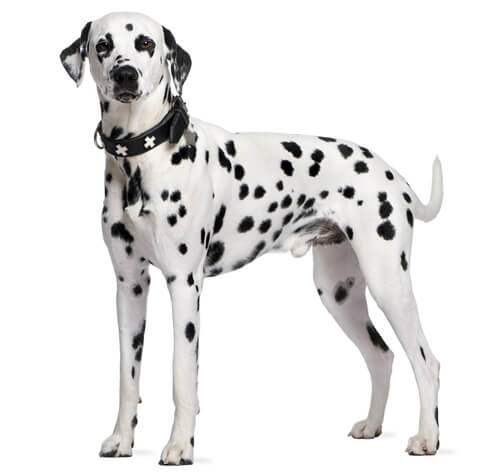
The only spotted breed of dog, the Dalmatian has an outgoing disposition and thrives with a loving family. The original coach dog, the Dalmatian is well-known for riding proudly atop a fire engine or running with a carriage. Having great endurance, the Dalmatian competes in long-distance road trials. This highly intelligent breed needs daily exercise, and his fine coat needs regular brushing to minimise shedding.
DID YOU KNOW? Dalmatians are born pure white, with the spots appearing around seven to 10 days.
ALSO KNOWN AS: Carriage Dog, Spotted Coach Dog, Firehouse Dog, Plum Pudding Dog
The need-to-know
- Dog suitable for experienced owners
- Some training required
- Enjoys vigorous walks
- Enjoys walking more than two hours a day
- Large dog
- Some drool
- Requires grooming every other day
- Non hypoallergenic breed
- Chatty and vocal dog
- Guard dog. Barks, alerts and it's physically protective
- May require training to live with other pets
- May require training to live with kids
Personality

The Dalmatian is friendly and outgoing, but if they are insufficiently exercised they can become hyperactive and difficult to live with. Dalmatians are dedicated and loyal and always want to please; they enjoy company and clowning about so can make great dogs for an active family, however, their strength and stamina - and need for almost endless exercise and stimulation - can sometimes be too much of a challenge for unprepared owners.
History and Origins

Country of Origin: England
Despite their name, it would seem that the Dalmatian is primarily an English breed with their first recorded use being by Thomas Berwick in 1791. Also known as the Spotted Coach Dog, not only are they the only truly spotted breed in the world, but they are also the only dedicated carriage dogs, bred to run alongside coaches either as a guard or a status symbol.
Dalmatians would accompany farmers’ wives and their pack ponies to market to ensure her safety. They were so good at this job that they began running alongside carriages to deter highwaymen - but as they were so showy they quickly became status symbols for the wealthy. They also found work running alongside horse-drawn fire engines. Their history may account for their reported affinity with horses.
Nutrition and Feeding

Your dog's diet needs to have the right balance of all the main nutrient groups including a constant supply of fresh water. It's also important to conduct regular body condition scores to ensure you keep your dog in ideal shape and remember to feed him at least twice daily and in accordance with the feeding guidelines of their particular food.
Exercise

This is a dog who was bred to run - all day, every day - and for most Dalmatians, this is their greatest joy. Couch potatoes need not apply! Dalmatians will need upwards of two hours of dog exercise every single day come rain or shine - and this needs to include free running. An under-exercised Dalmatian is difficult to live with. For an active owner however, the Dalmatian is a total joy as they will be up for every outing and will accompany even the most extreme fitness fanatics wherever they want to go. As with all dogs however, take care not to over-exercise puppies.
Other Information

Health and Common Issues
Deafness is the most common health problem within the Dalmatian breed, but dogs can be tested for deafness from a young age. They are also predisposed to a certain type of bladder stone.
Space Requirements
The Dalmatian is a large dog with extreme exercise requirements - and so needs a rural location and plenty of space.
Training Dalmatian Dogs
Dalmatians need plenty of early and ongoing dog socialisation, and also training to walk on a lead and harness. Also, as they need lots of free-running, owners must work to ensure they have a reliable recall. Most Dalmatians are easy to train as they enjoy working with their owners - although their exuberance sometimes means they can have a short attention-span!
Best Family Dog Breeds
As long as they get the exercise they need, the Dalmatian can make an excellent addition to an active energetic family - but they may be too boisterous for younger children (and few parents of younger children have the time to devote to their exercise needs). While many dogs are traditionally thought of as being good with children, all dogs and children need to be taught to get on with each other and be safe together. Even so, dogs and young children should never be left alone together and adults should supervise all interactions between them.